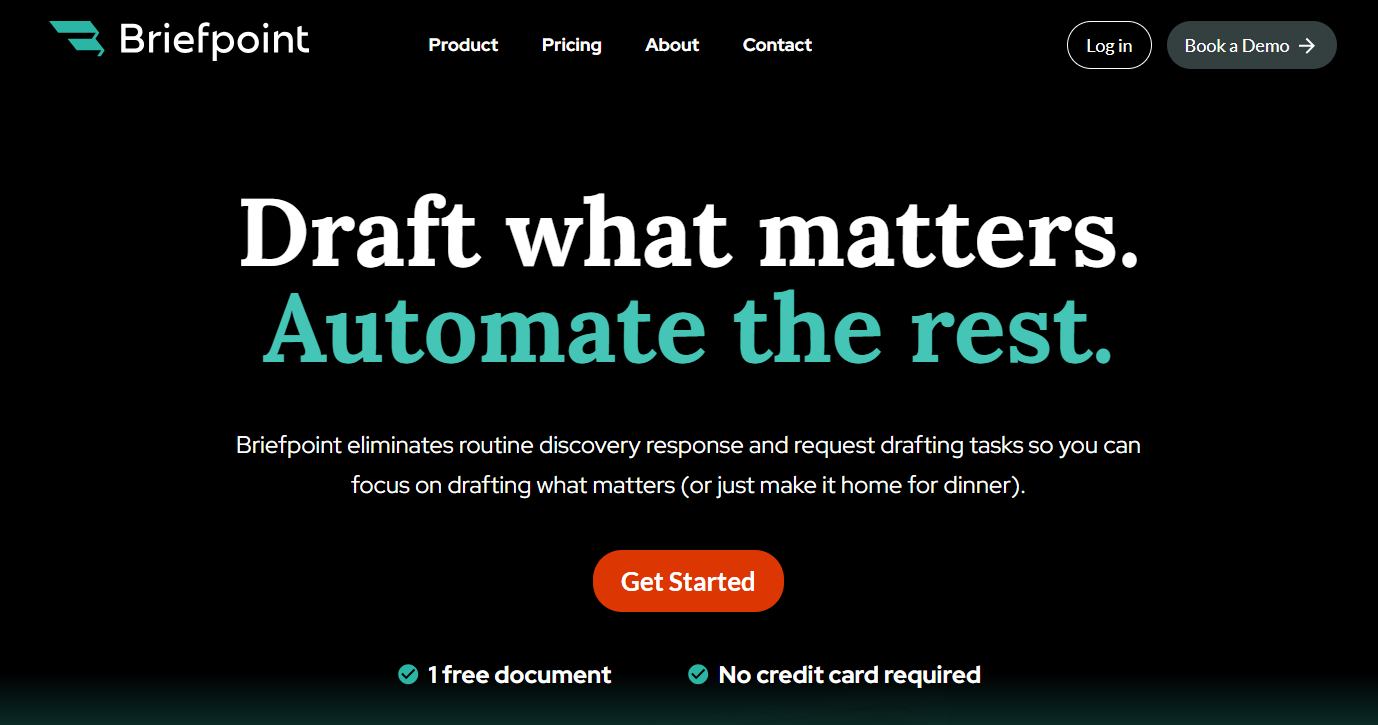What is Legal Drafting?
What is Legal Drafting?
Before contracts are signed or cases move forward, someone has to put the terms into writing. That’s what we call legal drafting. It’s the process of turning obligations, rights, and agreements into structured documents that carry legal weight.
Legal drafting is a core part of the legal profession, used daily in law firms, corporate legal departments, and even solo practices. And now, with legal drafting software taking on repetitive tasks, professionals can focus more on the actual thinking behind each document.
In this guide, you’ll learn what legal drafting really means, how it differs from legal writing, what the process looks like, and how AI tools are helping legal teams move faster.

Defining Legal Drafting
Legal drafting refers to the process of preparing legal documents that outline rights, duties, terms, or obligations. It plays a key role in the legal profession, especially in law firms where lawyers handle everything from contracts to court filings.
While legal drafting is often confused with legal writing, they’re not the same. Legal writing can include emails, memos, or research papers. Drafting, on the other hand, focuses on documents that can be legally enforced.
Good legal drafting avoids confusion by using clear, structured language. It revolves around getting the facts right and making sure everything holds up if the document is ever challenged.
Here are a few common types of documents and activities that involve legal drafting:
- Business contracts
- Employment agreements
- Non-disclosure agreements (NDAs)
- Lease or rental agreements
- Wills and trusts
- Legal notices or demand letters
- Court pleadings and motions
Whether you’re at a small practice or a large law firm, legal drafting is a must-have skill in the legal profession. It’s the foundation for many daily tasks and, in many cases, can make or break a case or deal.
What Does the Typical Legal Drafting Process Look Like?
If you’ve ever wondered how contracts, agreements, or discovery documents come together behind the scenes, you’re in the right place. There’s a method to the process; one that legal teams follow to avoid missteps down the line.
Let’s walk through it step by step.
1. Understand the Purpose and the People Involved
Before drafting documents, you need to know what you’re writing and who it’s for. Are you documenting a sale? An employment deal? Something more complex?
Corporate legal departments often start by meeting with the parties involved to clarify the purpose and key terms. A good draft begins with clear goals and expectations.
2. Do Your Legal Research
This part gets skipped too often, but it matters nonetheless. Effective legal drafting typically relies on knowing what the law says, what recent cases show, and how certain terms are usually interpreted.
Legal research supports not just contracts but legal opinions and internal memos, too. Without it, your document might leave loopholes you didn’t even see coming.
3. Outline the Structure
It’s like building a house, and you need a solid frame. For most contracts or agreements, there’s a standard structure:
- Introductions
- Responsibilities
- Timelines
- Payment terms
- Termination clauses
- Dispute handling
- Signatures
A clean outline keeps things organized and helps you spot what’s missing before you get too deep into the writing.
4. Start Drafting in Plain Language
Now comes the writing part, but not the overly fancy kind. Plain language is your best friend here. It helps avoid confusion, especially when people without legal training need to read and understand the document.
Stick to short sentences. Say what you mean. And be specific. Vague language can lead to arguments later.
5. Review, Revise, and Get Input
Once the first version is done, it’s time to loop in the right people. That might include colleagues, outside counsel, or the client. In corporate legal departments, multiple stakeholders may need to approve the draft.
Revisions usually focus on fixing unclear sections, correcting legal references, or updating terms based on the latest discussions.
6. Finalize and Execute
After back-and-forth revisions, legal professionals prepare the final version. It’s double-checked for accuracy, shared with all parties involved, and signed, either on paper or electronically.
At this stage, the document becomes enforceable and officially part of the legal process.

How Can AI and Automation Help?
Legal work is full of fine details, and when you’re creating documents meant to hold up in court or guide business deals, there’s no room for sloppy writing or missing terms.
But legal drafters aren’t always starting from scratch anymore. AI and legal automation tools are stepping in to handle repetitive tasks, reduce errors, and make things faster without cutting corners. Take a look at how AI helps:
Speeding Up the First Draft
Drafting legal documents often starts with a blank page and is a slow process. AI can skip that first hurdle by building a draft based on templates, prior agreements, or simple inputs.
These tools can pull from form books, past contracts, or even legal dictionaries to suggest solid starting points. As a result, you get a quicker path to a complete draft while still keeping control over the details that matter.
Breaking Down Complex Legal Concepts
Not everyone understands legal principles off the bat. AI tools can explain complex legal concepts in plain terms, or flag when wording is too technical for the reader.
For clients or junior legal drafters, that’s a big win. This shift toward straightforward language improves readability and helps reduce risk by avoiding ambiguity in enforceable documents that must stand up under scrutiny.
Improving Consistency Across Teams
In a busy legal practice, creating documents with consistent language can get tricky. This is especially true when multiple people are involved.
AI helps apply a structured method to drafting by suggesting preferred terms, aligning with internal style guides, and even checking references to relevant laws and regulations.
This keeps the written words aligned with the document’s purpose and cuts down on mix-ups caused by conflicting edits.
Supporting Legal Research and Accuracy
Legal workflow tools aren’t just for writing; they’re great at checking relevant facts, too. They can pull up relevant laws, case references, and sample clauses based on what you’re drafting. Some even suggest changes if a clause doesn’t match updated regulations.
This makes legal drafting skills easier to apply for newer drafters, which can bridge the gap between theory and practice without replacing legal expertise.
Reducing Back-and-Forth in Revisions
When you’re handling multiple drafts, input from different teams, and pressure to move fast, AI helps tighten the review process. It catches missing clauses, flags unclear sections, and spots inconsistencies before a human editor does.
In other words, it speeds up internal reviews and reduces the chance of disputes, whether you’re prepping for a deal or even litigation.
In short, it helps legal documentation stay sharp from start to finish.
Why Briefpoint Fits into Modern Legal Drafting
Drafting legal documents is one of those things that needs to be done right the first time. It takes more than legal knowledge to do it well. You need a clear process, the right structure, and language that avoids confusion.
And now, with AI tools stepping in, drafting is becoming faster and more accurate without losing the depth legal documents need.
Briefpoint is built specifically for that kind of work. It helps legal professionals draft discovery documents like Interrogatories, Requests for Admission, and Requests for Production across all U.S. states and federal districts.
You can upload a complaint, select your objections or responses, and download a properly formatted brief ready to open in Word. It even applies local formatting rules automatically and keeps your data secure with strong encryption.
If you’re tired of wasting hours on repetitive drafting and want a tool that works the way legal drafters do, check out Briefpoint. It’s fast, reliable, and already trusted by over 500 law firms.
FAQs About What Is Legal Drafting
What is considered legal drafting?
Legal drafting involves writing enforceable documents like contracts, pleadings, and discovery responses. It’s a core part of the legal industry and is used by legal experts to translate legal goals into formal, written agreements that follow relevant laws and procedures.
What is the purpose of drafting?
The purpose is to create clear, accurate documents that define rights and responsibilities. Since spoken words fade and written words remain, legal drafting helps make sure that there’s a reliable record. It’s about clear communication, avoiding disputes, and protecting the parties involved.
Is drafting legal documents hard?
It can prove intimidating at first, especially for those new to the legal field. But with the help of legal writing guides, citation style manuals, and tools like Briefpoint, drafting becomes more manageable, even for beginners.
What is the legal definition of draft?
A draft is a preliminary version of a legal document. It may go through several changes before being finalized. Drafts are often reviewed by legal experts to confirm accuracy and compliance with case law and local rules.
Why is legal drafting important?
It’s essential for ensuring documents are valid, enforceable, and easy to understand. Precise language, structured format, and attention to the intended audience all matter. A good draft helps prevent confusion, saves time, and supports fairness in legal matters, making it a key part of any beginner’s guide to the legal process.
The information provided on this website does not, and is not intended to, constitute legal advice; instead, all information, content, and materials available on this site are for general informational purposes only. Information on this website may not constitute the most up-to-date legal or other information.
This website contains links to other third-party websites. Such links are only for the convenience of the reader, user or browser. Readers of this website should contact their attorney to obtain advice with respect to any particular legal matter. No reader, user, or browser of this site should act or refrain from acting on the basis of information on this site without first seeking legal advice from counsel in the relevant jurisdiction. Only your individual attorney can provide assurances that the information contained herein – and your interpretation of it – is applicable or appropriate to your particular situation. Use of, and access to, this website or any of the links or resources contained within the site do not create an attorney-client relationship between the reader, user, or browser and website authors, contributors, contributing law firms, or committee members and their respective employers.
